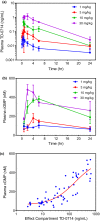Safety, Pharmacokinetics, and Pharmacodynamics of TD-0714, a Novel Potent Neprilysin Inhibitor in Healthy Adult and Elderly Subjects
- PMID: 32506827
- PMCID: PMC7719375
- DOI: 10.1111/cts.12831
Safety, Pharmacokinetics, and Pharmacodynamics of TD-0714, a Novel Potent Neprilysin Inhibitor in Healthy Adult and Elderly Subjects
Abstract
TD-0714 is an orally active, potent, and selective inhibitor of human neprilysin (NEP) in development for the treatment of chronic heart failure. Oral administration of TD-0714 in rats resulted in dose-dependent and sustained increases in plasma cyclic guanosine monophosphate (cGMP) over 24 hours consistent with NEP target engagement. Randomized, double-blind, placebo controlled, single ascending dose (50-600 mg TD-0714) and multiple ascending dose (10-200 mg TD-0714 q.d. for 14 days) studies were conducted in healthy volunteers. TD-0714 was generally well-tolerated and no serious adverse events or clinically significant effects on vital signs or electrocardiogram parameters were observed. TD-0714 exhibited dose-proportional pharmacokinetics (PKs) with high oral bioavailability, minimal accumulation after once daily dosing, and negligible renal elimination. Pharmacodynamic (PD) responses were observed at all dose levels studied, as reflected by statistically significant increases in plasma cGMP concentrations. The increases in cGMP were significantly above the baseline (~ 50-100%) on day 14 for the entire 24-hour interval indicating that sustained cGMP elevations are achieved at steady-state. Maximal steady-state cGMP response was observed in plasma and urine at doses ≥ 50 mg. The TD-0714 PK-PD relationship and safety profile were similar in elderly vs. younger adult subjects. The TD-0714 PK and PD profiles support further clinical development of TD-0714 and suggest the potential for once-daily administration and predictable exposure in patients with cardiorenal diseases regardless of their renal function.
© 2020 Theravance Biopharma US, Inc. Clinical and Translational Science published by Wiley Periodicals LLC on behalf of the American Society for Clinical Pharmacology and Therapeutics.
Conflict of interest statement
All authors are current or former employees of Theravance Biopharma US, Inc.
Figures



Similar articles
-
Safety, Tolerability, Pharmacokinetics and Quantitative Electroencephalography Assessment of ACD856, a Novel Positive Allosteric Modulator of Trk-Receptors Following Multiple Doses in Healthy Subjects.J Prev Alzheimers Dis. 2023;10(4):778-789. doi: 10.14283/jpad.2023.89. J Prev Alzheimers Dis. 2023. PMID: 37874100 Clinical Trial.
-
First-in-Human Study to Assess the Safety, Pharmacokinetics, and Pharmacodynamics of an Oral Formulation of DS-1040, an Inhibitor of the Activated Form of Thrombin-Activatable Fibrinolysis Inhibitor, in Healthy Subjects.J Clin Pharmacol. 2019 Dec;59(12):1669-1677. doi: 10.1002/jcph.1474. Epub 2019 Jun 27. J Clin Pharmacol. 2019. PMID: 31243790 Clinical Trial.
-
Pharmacokinetic and pharmacodynamic properties of multiple oral doses of sitagliptin, a dipeptidyl peptidase-IV inhibitor: a double-blind, randomized, placebo-controlled study in healthy male volunteers.Clin Ther. 2006 Jan;28(1):55-72. doi: 10.1016/j.clinthera.2006.01.015. Clin Ther. 2006. PMID: 16490580 Clinical Trial.
-
Tiotropium bromide. A review of its use as maintenance therapy in patients with COPD.Treat Respir Med. 2004;3(4):247-68. doi: 10.2165/00151829-200403040-00005. Treat Respir Med. 2004. PMID: 15350163 Review.
-
A randomized, double-blind, placebo-controlled, single, and multiple dose-escalation Phase I clinical trial to investigate the safety, pharmacokinetic, and pharmacodynamic profiles of oral S086, a novel angiotensin receptor-neprilysin inhibitor, in healthy Chinese volunteers.Expert Opin Investig Drugs. 2022 Sep;31(9):977-985. doi: 10.1080/13543784.2021.1985464. Epub 2021 Nov 8. Expert Opin Investig Drugs. 2022. PMID: 34633260 Clinical Trial.
Cited by
-
impHFrEF trial: study protocol for an open-label, multicentre study of improvement the outcome of patients with heart failure in China using a mobile hEalth-supported platForm.BMJ Open. 2024 Mar 29;14(3):e081011. doi: 10.1136/bmjopen-2023-081011. BMJ Open. 2024. PMID: 38553051 Free PMC article.
References
-
- Yancy, C.W. et al 2013 ACCF/AHA guideline for the management of heart failure: a report of the American College of Cardiology Foundation/American Heart Association Task Force on Practice Guidelines. J. Am. Coll. Cardiol. 62, e147–e239 (2013). - PubMed
-
- Volpe, M. Natriuretic peptides and cardio‐renal disease. Int. J. Cardiol. 176, 630–639 (2014). - PubMed
-
- Braunwald, E. The path to an angiotensin receptor antagonist‐neprilysin inhibitor in the treatment of heart failure. J. Am. Coll. Cardiol. 65, 1029–1041 (2015). - PubMed
-
- McMurray, J.J. et al Angiotensin‐neprilysin inhibition versus enalapril in heart failure. N. Engl. J. Med. 371, 993–1004 (2014). - PubMed
Publication types
MeSH terms
Substances
LinkOut - more resources
Full Text Sources
Molecular Biology Databases
Miscellaneous

